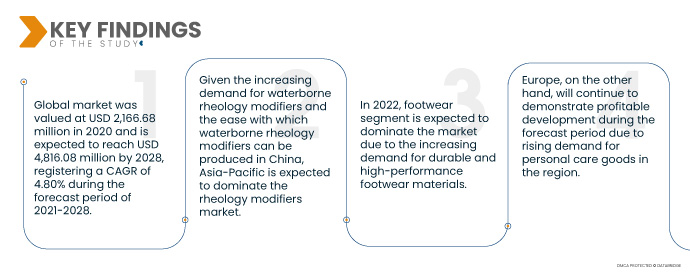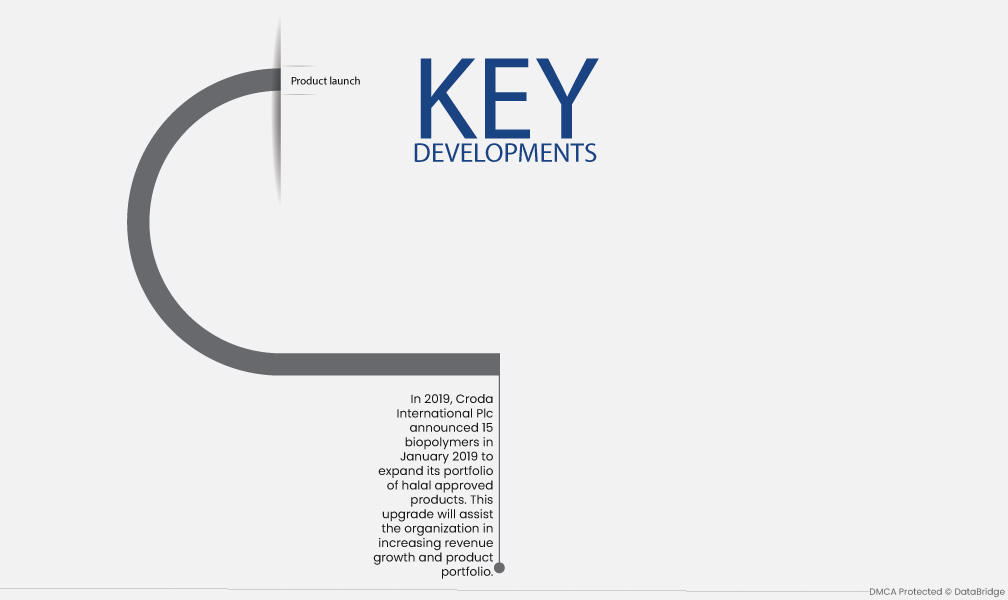During the forecast period, organic segment is predicted to grow at the quickest rate in the global rheology modifiers market. Organic rheology modifiers differ in chemistry from inorganic rheology modifiers. Natural raw materials, which are further classed as natural and synthetic, are included in the organic section. Organic rheology modifiers are in high demand across a wide range of applications. This is mostly owing to its positive characteristics, which include high performance and environmental friendliness.
Access Full Report @ https://www.databridgemarketresearch.com/reports/global-rheology-modifiers-market
Global Rheology Modifiers Market was valued at USD 2,166.68 million in 2020 and is expected to reach USD 4,816.08 million by 2028, registering a CAGR of 4.80% during the forecast period of 2021-2028. Growing use of liquid coating and rising crude oil output are two main factors that would likely drive the rheology modifiers market growth rate. Furthermore, rising consumer awareness of the importance of using high-quality beauty products would boost the growth of the rheology modifiers market.
Growing demand for personal care products is expected to drive the market's growth rate
Global demand for personal care products is expanding due to increased population and rising aesthetic awareness. Furthermore, the rise in disposable incomes in developed and emerging economies is a major factor to its expansion. The rheology market is also driven by the need for luxury products in the personal care market. The continuous rise in population, combined with improving economic conditions in emerging economies, is expected to generate larger housing transactions and more disposable income, driving the application of rheology in the construction industry for paints, adhesives, and coatings, which has a direct impact on the rheology modifiers market.
Report Scope and Market Segmentation
Report Metric
|
Details
|
Forecast Period
|
2021 to 2028
|
Base Year
|
2020
|
Historic Years
|
2019 (Customizable to 2013- 2018)
|
Quantitative Units
|
Revenue in USD Million, Volumes in Units, Pricing in USD
|
Segments Covered
|
Type (Waterborne, Solvent-borne), Nature (Organic, Inorganic), Distribution Channel (Direct Sales/B2B, Distributor/Third-Party Distributor/Agent/Trader, E-Commerce and Others), Form (Liquid, Solid), Functionality (Leveling Agent, Depressants, , Flow Promoters or Thinners, Thickener or Gelling Agents, Thixotropic Agents, Others), Applications (Adhesives and Sealants, Cement and Concrete, Cleaners and Disinfectants, Coolants, Rubber products, Fermentation, Lubricants and Greases, Others), End Users (Paints and Coatings, Inks, Personal Care, Cosmetics, Adhesives and Sealants, Textiles, Home Care, Pharmaceuticals, Construction, Pulp and Paper, Others)
|
Countries Covered
|
U.S., Canada and Mexico in North America, Germany, France, U.K., Netherlands, Switzerland, Belgium, Russia, Italy, Spain, Turkey, Rest of Europe in Europe, China, Japan, India, South Korea, Singapore, Malaysia, Australia, Thailand, Indonesia, Philippines, Rest of Asia-Pacific (APAC) in the Asia-Pacific (APAC), Saudi Arabia, U.A.E, South Africa, Egypt, Israel, Rest of Middle East and Africa (MEA) as a part of Middle East and Africa (MEA), Brazil, Argentina and Rest of South America as part of South America
|
Market Players Covered
|
ALTANA AG (Germany), Evonik Industries AG (Germany), BASF SE (Germany), Clariant (Switzerland), Ashland Inc. (U.S.), Dow (U.S.), Arkema (France), Cargill, Incorporated. (U.S.), The Lubrizol Corporation (U.S.), SNF Holding Company (U.S.), Mallard Creek Polymers (U.S.), Wanhua Chemical Group Co., Ltd. (China), DuPont (U.S.), Nouryon (Netherland), Eastman Chemical Company (U.S.), PPG Industries, Inc. (U.S.), Croda International Plc (U.K.), ELEMENTIS PLC (U.K.), The Euclid Chemical Company (U.S.) and Solvay (Belgium)
|
Data Points Covered in the Report
|
In addition to the insights on market scenarios such as market value, growth rate, segmentation, geographical coverage, and major players, the market reports curated by the Data Bridge Market Research also include in-depth expert analysis, geographically represented company-wise production and capacity, network layouts of distributors and partners, detailed and updated price trend analysis and deficit analysis of supply chain and demand
|
Segment Analysis:
The rheology modifiers market is segmented on the basis of type, nature, distribution channel, and applications.
- On the basis of type, the global rheology modifiers market is segmented into waterborne and solvent borne.
In 2021, the waterborne treatment segment of type segment is anticipated to dominate the rheology modifiers market
Waterborne treatment segment is expected to dominate global rheology modifiers market with 66.24% market share because waterborne products aid in binding formation all liquids chemical products and are extensively used in the paint and coating sectors, increasing its demand globally. Furthermore, the increasing demand for waterborne products owing to the easy availability of rheology modifiers liquids highly used in the coloring products is expected to drive the market growth rate.
- On the basis of nature, the global rheology modifiers market is segmented into organic and inorganic. In 2021, organic segment is expected to dominate global rheology modifiers market with 76.18% market share because organic product are formed by natural resource and very less synthetic chemicals are used in these products which is growing its demand in the global market.
- On the basis of form, the rheology modifiers market is segmented into liquid and solid.
- On the basis of functionality, the market is segmented into leveling agent, depressants, flow promoters or thinners, thickener or gelling agents, thixotropic agents and others.
- 根據分銷管道,全球流變改質劑市場細分為直銷/b2b、分銷商/第三方分銷商/代理商/貿易商、電子商務和其他。
預計到 2021 年,直銷/B2B 部門將佔據流變改質劑市場分銷通路領域的最大 份額
預計直銷/B2B 將佔據全球流變改質劑市場的 72.58% 份額,因為流變改質劑產品被廣泛用作行業成品生產的原材料,從而在全球範圍內推動其需求激增。
- 根據應用,全球流變改質劑市場分為油漆和塗料、油墨、個人護理和化妝品、黏合劑和密封劑、紡織品、家庭護理、製藥、建築、紙漿和造紙等。 2021 年,油漆和塗料領域預計將以 33.01% 的市場份額佔據全球流變改質劑市場的主導地位,因為油漆產品在保護表面免受環境影響方面具有多種應用,這導致全球對油漆和塗料的需求不斷增加。
- 根據最終用戶,流變改質劑市場細分為油漆和塗料、油墨、個人護理、化妝品、黏合劑和密封劑、紡織品、家庭護理、製藥、建築、紙漿和造紙等。
主要參與者
Data Bridge Market Research 將以下公司視為主要市場參與者:ALTANA AG(德國)、Evonik Industries AG(德國)、BASF SE(德國)、Clariant(瑞士)、Ashland Inc.(美國)、Dow(美國)、Arkema(法國)、Cargill, Incorporated。 (美國)、路博潤公司(美國)、SNF 控股公司(美國)、Mallard Creek Polymers(美國)、萬華化學集團股份有限公司(中國)、杜邦公司(美國)、諾力昂(荷蘭)、伊士曼化學公司(美國)、PPG 工業公司(美國)、禾大國際有限公司(英國)、ELEMENTIS PLC(比利時)公司(比利時)、美國)、美國比利時)。
市場開發
- 2019年1月,禾大國際有限公司宣布推出15種生物聚合物,以擴大其清真認證產品組合。符合清真標準的成分包括脂肪酸和醇、保濕劑、界面活性劑、潤膚劑、無機紫外線過濾劑、羊毛脂及其衍生物、膠凝劑、特殊混合物和基質、流變改質劑、特種陽離子化合物、活性成分和植物萃取物。此次升級將有助於該組織增加收入和產品組合。
區域分析
從地理上看,市場報告涵蓋的國家有:北美洲的美國、加拿大和墨西哥、歐洲的德國、法國、英國、荷蘭、瑞士、比利時、俄羅斯、義大利、西班牙、土耳其、歐洲其他地區、中國、日本、印度、韓國、新加坡、馬來西亞、澳洲、泰國、印尼、菲律賓、亞太地區(APAC)的其他地區、沙烏地阿拉伯、阿聯酋、南非、澳洲、其他國家的歐洲、歐洲、歐洲地區和其他國家的歐洲地區(歐洲地區的歐洲國家。
根據 Data Bridge 市場研究分析:
2021-2028 年預測期間內,亞太地區是流變改質劑市場的主導地區
鑑於對水性流變改質劑的需求不斷增加以及中國生產水性流變改質劑的便利性,預計亞太地區將主導流變改質劑市場。
預計2021-2028 年預測期內歐洲將成為流變改質劑 市場成長最快的地區
預計歐洲將在 2022 年至 2029 年期間保持穩定成長。由於該地區對個人護理用品的需求不斷增長,預測期內歐洲將繼續呈現獲利成長。
有關流變改質劑 市場 報告的更多詳細信息,請單擊此處 - https://www.databridgemarketresearch.com/reports/global-rheology-modifiers-market












